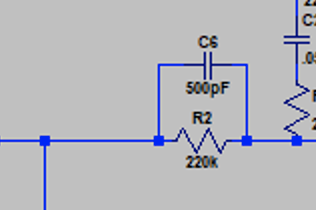LTSPICE Analysis | John Mayer Two-Rock Signature
- Ryan

- Dec 12, 2018
- 3 min read
Using LTSPICE, I modeled the Two-Rock John Mayer Signature to understand more about the circuit. LTSPICE makes it easy to change resistor/capacitor values and see a graph of the signal throughout the circuit. It was a bit of a learning curve as I've never had simulated circuits in such detail like this. I borrowed some bits and pieces of open source LTSPICE models around the internet to pull it all together.
One thing I noticed while researching the JM Sig circuit is that Amplified Nation posted a layout of a real Two-Rock JM Sig that he had in his possession and around that same time, Ceriatone offered a layout of their Joyful Music amplifiers which is supposed to be very close to the Two-Rock. When I built my JM Sig circuit, I used a Ceriatone kit so I went with their layout 1:1 for the first round. The amp sounded great with Celestion G12-65H speakers and was very Fender-y to my ears. I added a switch to my amp that would toggle between the adding the bass jumper and removing it. Sure enough, adding the bass jumper changed the tone knob interaction quite a bit and lining up settings to pictures of John Mayer's live performances seemed to nail "that sound" of his!

Below is a gallery for full screen viewing
Ceriatone-Style with no bass pot jumper (According to this layout) Joyful Music tone stack on the bottom of the AC analysis.
I've added a YouTube video going over how I'm using LTSPICE and walk through how I'm manipulating the circuit and viewing results.
And here is a video I made to demonstrate some tonal difference between the two tone stack approaches.

One other thing I'm learning about this circuit as compared to a Dumble Steel String Singer is how the John Mayer Signature amplifier has a set filter to make the strat sound so amazing. The JM Sig cancels out a lot of upper end harmonics resulting in a "darker" amplifier but that's not necessarily a bad thing. It's very ear pleasing, although some sound engineers might argue that it's tougher for the guitar to cut through the mix.
One thing I spotted is a 500pf/220k combination after the first gain section and before V1b. I've seen this as sort of a treble bleed or bright cap scenario so I played with the model. It appears to swing the upper end roll of to around 5kHz as compared to 4kHz without the 500pf cap. There also must be some interaction in how this combination drops the gain out of the dry signal. Note: I set the analysis probe at the end of the dry signal and before it's mixed in with the reverb to get an idea how the who dry signal works together post this change. I'm still learning but I think this is a logical approach.
Next up I'll simulate a Dumble Steel String Singer circuit with the step filters to learn more about the interactions.
I'm going to start hosting my LTSPICE simulations and 3D AutoCAD projects on GitHub. This allows me to quick publish updates and you can monitor changes in real-time. Soon, I will be kicking off a YouTube VLog how I made my Steel String Singer chassis, artwork, cabinet which I will host all supplemental information on GitHub so you can play along at home. I am giving this information away for free use to better the existing rock and roll community, as well as inspire folks to get into this rewarding hobby. I kindly ask that you link my site/YouTube if you publish any of your own findings based on what you learned here :-)
I accept nominal donations here https://www.paypal.me/thetonegeek
as well as have an Amazon Wish List. If you donate an item from the wish list, I will do a video review of said item :-)









































That sounds like a really helpful video, especially for anyone trying to learn LTSPICE! If you’re looking to polish your tutorial or make it more engaging, I’d recommend trying no watermark video editor. It’s super easy to use, and it’s great for editing educational content. You can enhance your videos with annotations or smooth transitions, making it even easier for viewers to follow along!